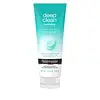What's inside
What's inside
 Key Ingredients
Key Ingredients

 Benefits
Benefits

 Concerns
Concerns

 Ingredients Side-by-side
Ingredients Side-by-side

Water
Skin ConditioningGlycerin
HumectantMyristic Acid
CleansingStearic Acid
CleansingPotassium Hydroxide
BufferingLauric Acid
CleansingPalmitic Acid
EmollientPEG-32
HumectantCocamidopropyl Betaine
CleansingSodium Cocoyl Glycinate
CleansingPEG-100 Stearate
Glyceryl Stearate
EmollientPhenoxyethanol
PreservativePEG-75
HumectantSodium Chloride
MaskingParfum
MaskingPEG-150 Distearate
EmulsifyingPolyquaternium-7
Ethylhexylglycerin
Skin ConditioningDisodium EDTA
Capric Acid
CleansingHydrolyzed Hyaluronic Acid
HumectantMoringa Oleifera Seed Extract
Skin ConditioningWater, Glycerin, Myristic Acid, Stearic Acid, Potassium Hydroxide, Lauric Acid, Palmitic Acid, PEG-32, Cocamidopropyl Betaine, Sodium Cocoyl Glycinate, PEG-100 Stearate, Glyceryl Stearate, Phenoxyethanol, PEG-75, Sodium Chloride, Parfum, PEG-150 Distearate, Polyquaternium-7, Ethylhexylglycerin, Disodium EDTA, Capric Acid, Hydrolyzed Hyaluronic Acid, Moringa Oleifera Seed Extract
Triethylhexanoin
MaskingIsopropyl Palmitate
EmollientCaprylic/Capric Triglyceride
MaskingSorbeth-30 Tetraoleate
EmulsifyingCetyl Ethylhexanoate
EmollientOlea Europaea Fruit Oil
MaskingCocos Nucifera Oil
MaskingParfum
MaskingCoco-Caprylate/Caprate
EmollientLinalool
PerfumingLimonene
PerfumingHelianthus Annuus Seed Oil
EmollientPrunus Armeniaca Kernel Oil
MaskingSimmondsia Chinensis Seed Oil
EmollientOryza Sativa Bran Oil
EmollientCamellia Sinensis Seed Oil
HumectantPrunus Amygdalus Dulcis Oil
Skin ConditioningWater
Skin ConditioningPhytosteryl/Octyldodecyl Lauroyl Glutamate
Skin ConditioningButylene Glycol
HumectantPropanediol
Solvent1,2-Hexanediol
Skin ConditioningAcorus Calamus Root Extract
PerfumingEthylhexylglycerin
Skin ConditioningDisodium EDTA
Camellia Sinensis Leaf Extract
AntimicrobialTocopherol
AntioxidantTriethylhexanoin, Isopropyl Palmitate, Caprylic/Capric Triglyceride, Sorbeth-30 Tetraoleate, Cetyl Ethylhexanoate, Olea Europaea Fruit Oil, Cocos Nucifera Oil, Parfum, Coco-Caprylate/Caprate, Linalool, Limonene, Helianthus Annuus Seed Oil, Prunus Armeniaca Kernel Oil, Simmondsia Chinensis Seed Oil, Oryza Sativa Bran Oil, Camellia Sinensis Seed Oil, Prunus Amygdalus Dulcis Oil, Water, Phytosteryl/Octyldodecyl Lauroyl Glutamate, Butylene Glycol, Propanediol, 1,2-Hexanediol, Acorus Calamus Root Extract, Ethylhexylglycerin, Disodium EDTA, Camellia Sinensis Leaf Extract, Tocopherol
 Reviews
Reviews

Ingredients Explained
These ingredients are found in both products.
Ingredients higher up in an ingredient list are typically present in a larger amount.
Disodium EDTA plays a role in making products more stable by aiding other preservatives.
It is a chelating agent, meaning it neutralizes metal ions that may be found in a product.
Disodium EDTA is a salt of edetic acid and is found to be safe in cosmetic ingredients.
Learn more about Disodium EDTAEthylhexylglycerin (we can't pronounce this either) is commonly used as a preservative and skin softener. It is derived from glyceryl.
You might see Ethylhexylglycerin often paired with other preservatives such as phenoxyethanol. Ethylhexylglycerin has been found to increase the effectiveness of these other preservatives.
Parfum is a catch-all term for an ingredient or more that is used to give a scent to products.
Also called "fragrance", this ingredient can be a blend of hundreds of chemicals or plant oils. This means every product with "fragrance" or "parfum" in the ingredients list is a different mixture.
For instance, Habanolide is a proprietary trade name for a specific aroma chemical. When used as a fragrance ingredient in cosmetics, most aroma chemicals fall under the broad labeling category of “FRAGRANCE” or “PARFUM” according to EU and US regulations.
The term 'parfum' or 'fragrance' is not regulated in many countries. In many cases, it is up to the brand to define this term.
For instance, many brands choose to label themselves as "fragrance-free" because they are not using synthetic fragrances. However, their products may still contain ingredients such as essential oils that are considered a fragrance by INCI standards.
One example is Calendula flower extract. Calendula is an essential oil that still imparts a scent or 'fragrance'.
Depending on the blend, the ingredients in the mixture can cause allergies and sensitivities on the skin. Some ingredients that are known EU allergens include linalool and citronellol.
Parfum can also be used to mask or cover an unpleasant scent.
The bottom line is: not all fragrances/parfum/ingredients are created equally. If you are worried about fragrances, we recommend taking a closer look at an ingredient. And of course, we always recommend speaking with a professional.
Learn more about ParfumWater. It's the most common cosmetic ingredient of all. You'll usually see it at the top of ingredient lists, meaning that it makes up the largest part of the product.
So why is it so popular? Water most often acts as a solvent - this means that it helps dissolve other ingredients into the formulation.
You'll also recognize water as that liquid we all need to stay alive. If you see this, drink a glass of water. Stay hydrated!
Learn more about Water